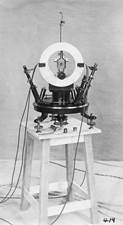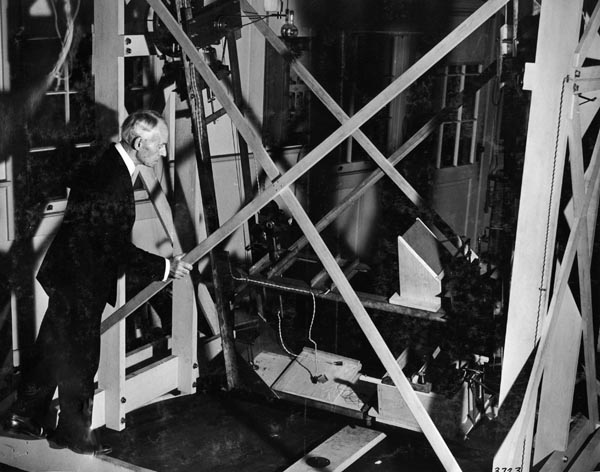Geomagnetic Apparatus
 |
| Adolf Widmer, chief mechanician, at work bench in DTM instrument shop in 1909, Image No. I8. |
At its founding in 1904, the Department of Terrestrial Magnetism’s primary scientific mission was to map out accurately and determine the origin of the Earth’s magnetic field. Consequently, the early instrument photographs taken by DTM are of geomagnetic instruments. In 1908, DTM opened a machine shop in its rented quarters at the Ontario Apartments in Washington, DC. With the shop on site, the department could easily modify instruments they acquired as well as design their own apparatus for geomagnetic measurements. When DTM moved to its current location on Broad Branch Road in 1914, the new facilities featured a non-magnetic wooden building built solely for instrument standardization. Often, several views of an instrument were taken, including a view of the disassembled instrument in its specialized travelling case.
 |
| Sine-galvanometer, 1921, Image No. I419. |
To measure the Earth’s magnetic field at any given point requires that the direction of the three components of the field and its intensity be determined. This involves finding the declination, which is the angle of deviation from true north, and the inclination, or dip, which is the angle formed by the horizontal plane at the observation location and the line of force in the magnetic meridian. The declination could be measured with a compass or magnetometer and astronomical observation of true north. Inclination could be measured with a dip circle or an Earth inductor. The intensity, or magnitude, of the field could then be determined using the values of the measured components. The intensity could also be determined using the null electromagnetic method, in which the known magnetic field of an electric current passing through a coil is compared to the unknown horizontal component of the Earth’s magnetic field at the center of the coil. This measurement required the use of a sine-galvanometer.
 |
| Swing for determining compass variations due to dynamic effects, taken 1935, Image No. I3723. |
Scientists at DTM continued developing and modifying geomagnetic instruments until the end of World War II, when the department left the study of terrestrial magnetism to dedicate its resources in other areas of research. A representative sample of significant geomagnetic instruments dating from the beginning of the twentieth century to the end of World War II that were constructed all over the world is found in the instrument photograph collection.
